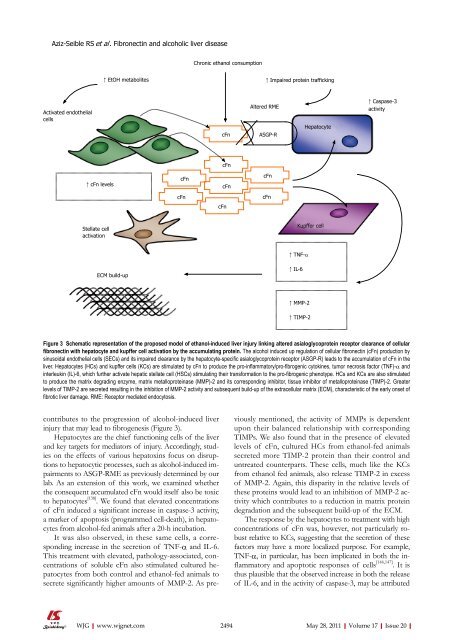20 - World Journal of Gastroenterology
20 - World Journal of Gastroenterology
20 - World Journal of Gastroenterology
You also want an ePaper? Increase the reach of your titles
YUMPU automatically turns print PDFs into web optimized ePapers that Google loves.
Aziz-Seible RS et al . Fibronectin and alcoholic liver disease<br />
Activated endothelial<br />
cells<br />
↑ cFn levels<br />
Stellate cell<br />
activation<br />
↑ EtOH metabolites ↑ Impaired protein trafficking<br />
ECM build-up<br />
contributes to the progression <strong>of</strong> alcohol-induced liver<br />
injury that may lead to fibrogenesis (Figure 3).<br />
Hepatocytes are the chief functioning cells <strong>of</strong> the liver<br />
and key targets for mediators <strong>of</strong> injury. Accordingly, studies<br />
on the effects <strong>of</strong> various hepatoxins focus on disruptions<br />
to hepatocytic processes, such as alcohol-induced impairments<br />
to ASGP-RME as previously determined by our<br />
lab. As an extension <strong>of</strong> this work, we examined whether<br />
the consequent accumulated cFn would itself also be toxic<br />
to hepatocytes [138] . We found that elevated concentrations<br />
<strong>of</strong> cFn induced a significant increase in caspase-3 activity,<br />
a marker <strong>of</strong> apoptosis (programmed cell-death), in hepatocytes<br />
from alcohol-fed animals after a <strong>20</strong>-h incubation.<br />
It was also observed, in these same cells, a corresponding<br />
increase in the secretion <strong>of</strong> TNF-a and IL-6.<br />
This treatment with elevated, pathology-associated, concentrations<br />
<strong>of</strong> soluble cFn also stimulated cultured hepatocytes<br />
from both control and ethanol-fed animals to<br />
secrete significantly higher amounts <strong>of</strong> MMP-2. As pre-<br />
WJG|www.wjgnet.com<br />
cFn<br />
cFn<br />
Chronic ethanol consumption<br />
cFn<br />
cFn<br />
cFn<br />
cFn<br />
Altered RME<br />
ASGP-R<br />
cFn<br />
cFn<br />
Hepatocyte<br />
Kupffer cell<br />
↑ TNF-a<br />
↑ IL-6<br />
↑ MMP-2<br />
↑ TIMP-2<br />
↑ Caspase-3<br />
activity<br />
Figure 3 Schematic representation <strong>of</strong> the proposed model <strong>of</strong> ethanol-induced liver injury linking altered asialoglycoprotein receptor clearance <strong>of</strong> cellular<br />
fibronectin with hepatocyte and kupffer cell activation by the accumulating protein. The alcohol induced up regulation <strong>of</strong> cellular fibronectin (cFn) production by<br />
sinusoidal endothelial cells (SECs) and its impaired clearance by the hepatocyte-specific asialoglycoprotein receptor (ASGP-R) leads to the accumulation <strong>of</strong> cFn in the<br />
liver. Hepatocytes (HCs) and kupffer cells (KCs) are stimulated by cFn to produce the pro-inflammatory/pro-fibrogenic cytokines, tumor necrosis factor (TNF)-a and<br />
interleukin (IL)-6, which further activate hepatic stellate cell (HSCs) stimulating their transformation to the pro-fibrogenic phenotype. HCs and KCs are also stimulated<br />
to produce the matrix degrading enzyme, matrix metalloproteinase (MMP)-2 and its corresponding inhibitor, tissue inhibitor <strong>of</strong> metalloproteinase (TIMP)-2. Greater<br />
levels <strong>of</strong> TIMP-2 are secreted resulting in the inhibition <strong>of</strong> MMP-2 activity and subsequent build-up <strong>of</strong> the extracellular matrix (ECM), characteristic <strong>of</strong> the early onset <strong>of</strong><br />
fibrotic liver damage. RME: Receptor mediated endocytosis.<br />
viously mentioned, the activity <strong>of</strong> MMPs is dependent<br />
upon their balanced relationship with corresponding<br />
TIMPs. We also found that in the presence <strong>of</strong> elevated<br />
levels <strong>of</strong> cFn, cultured HCs from ethanol-fed animals<br />
secreted more TIMP-2 protein than their control and<br />
untreated counterparts. These cells, much like the KCs<br />
from ethanol fed animals, also release TIMP-2 in excess<br />
<strong>of</strong> MMP-2. Again, this disparity in the relative levels <strong>of</strong><br />
these proteins would lead to an inhibition <strong>of</strong> MMP-2 activity<br />
which contributes to a reduction in matrix protein<br />
degradation and the subsequent build-up <strong>of</strong> the ECM.<br />
The response by the hepatocytes to treatment with high<br />
concentrations <strong>of</strong> cFn was, however, not particularly robust<br />
relative to KCs, suggesting that the secretion <strong>of</strong> these<br />
factors may have a more localized purpose. For example,<br />
TNF-a, in particular, has been implicated in both the inflammatory<br />
and apoptotic responses <strong>of</strong> cells [146,147] . It is<br />
thus plausible that the observed increase in both the release<br />
<strong>of</strong> IL-6, and in the activity <strong>of</strong> caspase-3, may be attributed<br />
2494 May 28, <strong>20</strong>11|Volume 17|Issue <strong>20</strong>|

















